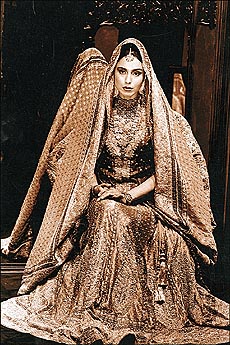Dolling up
for wedding season
Fashion
By Suneeta
Bahl
DESIGNERS are working overtime for
the wedding season in India. And it is not just bridal
wear they are concerned about, they are also creating
newer styles and looks for all those who need to grace
the big occasion.
 So it is more of a celebration of
expensive silks and chiffon, of exquisite mirror-work and
zardozi embroidery, apart from gold ornaments and
glittering gems that the fashion circles are witnessing
at this time of the year. After all, an Indian wedding is
always a grand spectacle. So it is more of a celebration of
expensive silks and chiffon, of exquisite mirror-work and
zardozi embroidery, apart from gold ornaments and
glittering gems that the fashion circles are witnessing
at this time of the year. After all, an Indian wedding is
always a grand spectacle.
Nothing can be more
representative of prevailing mood than the song and dance
designers are making over the traditional saree. From
elaborate shararas and ghararas, they have
suddenly shifted their attention to the urbanised drape
in all its indigenous glory.
The weave, texture, yarn
and colours are all being resurrected, be it the
Maheshwari or Chanderi sarees of Madhya Pradesh, the
Benarasis or Jamdanis of Bengal, the Patolas or Paithanis
of Maharashtra or the Sambalpuris and Vichitrapuris of
Orissa.
All these are saree
traditions rooted to the Indian culture. And just as it
has become fashionable to go back in time in every other
walk of life, the high priests of fashion are making the
most of a forgotten heritage in designing wedding
trousseaus.
Accordingly pre-stitched
and zip-up sarees do not find a place in wedding wear.
One saree that continues to be a hot favourite with the
bride and guests is the South Indian Kanjeevaram. Its
popularity cuts across caste community and regional
lines.
Another distinctive
trend is the emergence of the odhni as an
important accessory to the wedding saree. Traditionally
worn as a kind of muffler or scarf with salwar-kameezes,
it is now being draped over both shoulders as a shawl,
often substituting for the aanchal.
Designers like Shaina
N.C. Point out that the double odhni is most
graceful when worn with the saree. The saree could be
Chanderi and the odhni in jacquard crepe attached
to its pleats. Another version: a six-metre odhni worn
over one shoulder to create a cowl at the back by
bringing over the other shoulders.
Hemant Trivedi offers
yet another option by using the odhni as an "Eastern
extension of the scarf" by draping it on the neck
and letting it flow behind. On an off-beat note, Wendell
Rodricks suggests turning it into a circular ring over
one shoulder or extending the pallu of the saree
to form one.
With the odhni assuming
such importance, almost all designers are venting their
creativity on its expanse and embellishing it with zari,
zardosi, resham, tili, sequins and beads. The more
adventurous go for hand-paint or block-print. In fact,
when it comes to bridal wear, the odhni often weighs more
than the garment.
Style guru Tarun
Tahiliani has a wonderful trousseau collection this year
with transparent, heavily embroidered sarees, combined
with blouses and petticoats in satin, the focus being on
comfort and elegance. The cut and the work (including
pearl embroidery) on blouses is exquisite.
There are also designers
like Ritu Beri and J.J. Valaya who are repeating lehenga-cholis
with minor changes. One innovation is the bajuband
dupatta which can be draped over the shoulders for a
regal look and feel. The lehenga, dupatta and choli are
intricately embroidered.
These designer
trousseaus are known for the mix of fabrics like
brocades, jacquard, silk and velvet. The colours range
from neutral and beige for the wedding to black for the
cocktail evening, eliminating the expected reds and
yellows.
As for the groom, Valaya
recommends designs that are "individual-based and
personality friendly" which can be worn on or before
the wedding day. Go for the matt finish, be subtle, yet
luxurious in the use of embroidery, he advises. — (MF)

|

![]()

